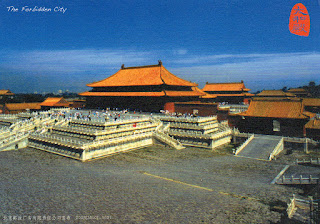This site always brings me to my memory the film The Last Emperor, and now that I'm posting this I want to see it again because it was a long time ago that I watched it on TV and I can hardly remember.
 |
| The Forbidden City |
The Forbidden City was the Chinese imperial palace from the Ming dynasty to the end of the Qing dynasty—the years 1420 to 1912. It is located in the center of Beijing, China, and now houses the Palace Museum. It served as the home of emperor sand their households as well as the ceremonial and political centre of Chinese government for almost 500 years.
 |
| The Forbidden City |
This postcard was sent by Luo
Constructed from 1406 to 1420, the complex consists of 980 buildings and covers 72 ha (180 acres). The palace complex exemplifies traditional Chinese palatial architecture, and has influenced cultural and architectural developments in East Asia and elsewhere. The Forbidden City was declared a World Heritage Site in 1987, and is listed by UNESCO as the largest collection of preserved ancient wooden structures in the world.
 |
| The Empress Bedroom |
Since 1925, the Forbidden City has been under the charge of the Palace Museum, whose extensive collection of artwork and artefacts were built upon the imperial collections of the Ming and Qing dynasties. Part of the museum's former collection is now located in the National Palace Museum in Taipei. Both museums descend from the same institution, but were split after the Chinese Civil War. The Forbidden City has over 14 million annual visitors. - in: wikipedia































